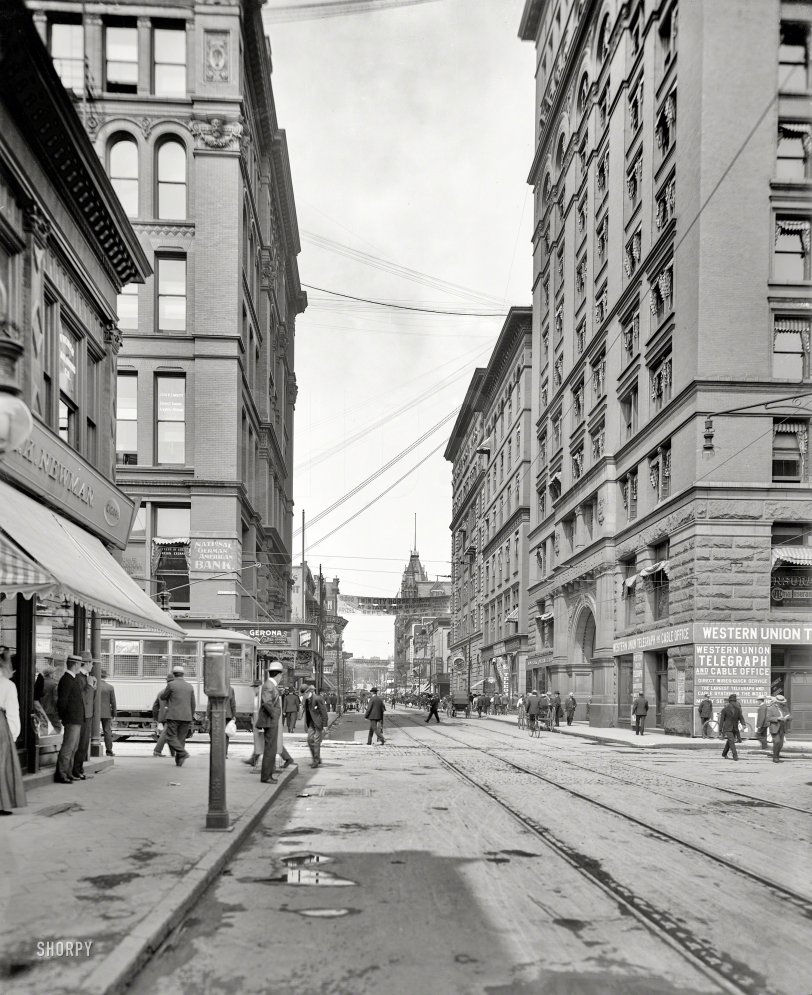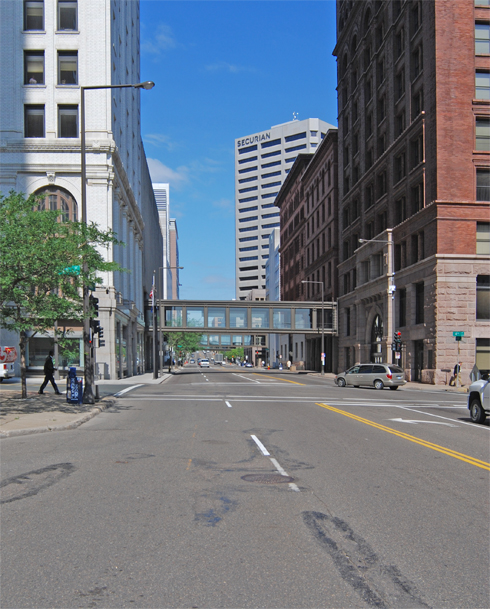


Framed or unframed, desk size to sofa size, printed by us in Arizona and Alabama since 2007. Explore now.
Shorpy is funded by you. Patreon contributors get an ad-free experience.
Learn more.

- Baldwin 62303
- Baldwin VO-1000
- Cold
- No expense spared
- Tough Guys
- Lost in Toyland
- And without gloves
- If I were a blindfolded time traveler
- Smoke Consumer Also Cooks
- Oh that stove!
- Possibly still there?
- What?!?
- $100 Reward
- Freeze Frame
- Texas Flyer wanted
- Just a Year Too Soon
- WWII -- Replacing men with women at the railroad crossing.
- Yes, Icing
- You kids drive me nuts!
- NOT An Easy Job
- I wonder
- Just add window boxes
- Icing Platform?
- Indiana Harbor Belt abides
- Freezing haze
- Corrections (for those who care)
- C&NW at Nelson
- Fallen Flags
- A dangerous job made worse
- Water Stop
Print Emporium
Pioneer Press: 1904

1904. "Robert Street and Pioneer Press -- St. Paul, Minnesota." 8x10 inch dry plate glass negative, Detroit Photographic Company. View full size.
Re: The Sanborns
Amazing what you can learn just from reading the comments! Even learn some history about your own town of Corinth, Mississippi while reading a post about St. Paul, Minnesota. Gotta love Shorpy!
Re: Me
Paul A - Thank you very much for your kind words.
The camera I used in most of the photos posted on Shorpy is a Nikon D90. Some of those dated earlier were taken with either a Nikon D80 or a Nikon D70 (I've upgraded through the years but have stayed with the D90 - it's a great camera). Some of the much earlier shots were taken with Nikon N90 and Nikon N70 film cameras where I scanned the slides.
What makes many of the shots is actually the lens I use - it's a Nikon 18-200 VR. It's a great lens.
Regarding the perspective correction, the 18-200 lens often makes further correction unnecessary (depending on the distance to the subject). However, in many cases (such as the shot above), I use Photoshop to correct the perspective (such as when the view forces the camera to be at an inclined angle which makes the buildings look as if they are leaning in toward one another).
I do have two Nikon shift lenses that I have used which correct for perspective when the shot is taken, but it's been a while since I've used them. They are fixed focal lengths, not very wide (less so when used on my D90), and not as crisp as my 18-200.
I hope this helps.
timeandagainphoto
Sorry if this has been addressed in previous posts but please share what camera you use. I ask because your parallax correction is always wonderful as your photos.
12/29 add: Thanks t&ap! You gave me guidance to jump into architectural photography again. Time to upgrade from "instamatic" digital without the huge cost of digitizing my medium format or 4x5. Please keep your great +photos coming!
+104
Below is the same view from September of 2008.

+110
Now known as the Pioneer-Endicott building, it is being converted into a residential property. The streetcars are long gone from Robert Street, but light rail now passes by on 4th.
1904 vs. 2014: What's Different?
Apparently, Americans in 1904 weren't fat.
Cigars and Horses
In most of these photos from the early 20th century, there seem to be multiple cigar stores on every block. Also, the $8,000 in prizes at the horse show would now be $205,000 in 2014 dollars.
The Streetcar Returns
Shorpy is looking north on Robert Street at Fourth. The Pioneer Press building is still standing, as are the next two on the right.
Both streetcar lines were abandoned in 1954, but in 2014 a new streetcar line, dubbed "light rail" but it's still a streetcar line, was reopened on Fourth Street after a 60-year absence.
The Sanborns
What I would give to have walked two flights up the stairwell of the German National German-American Bank Building about 1900, knocked on the doors of rooms 66 to 69, and thereby encountered former Civil War Adj. Gen. John B. Sanborn, his nephew (and alderman) Edward Sanborn, his law-student son (and future Eighth Circuit judge) John B. Sanborn Jr, and perhaps his other nephew, Eighth Circuit Judge Walter Sanborn (visiting while riding the Circuit from Arkansas to the Dakotas to the Rockies). The Sanborns bridged the Civil War and the civil rights movements of the mid-20th century; John Sr. led troops into battle in Iuka, Corinth, and Vicksburg, while John Jr. played an important role in upholding the orders desegregating Central High and the rest of Little Rock's public schools. John Sr. died on May 6, 1904. Judging from the dates on the "Horse Show" banner, this photo was taken shortly thereafter.
Pacific Postal Telegraph Cable
Postal Telegraph Cable, down the street, was trying to break the Western Union monopoly. Lots of court cases. It's surprisingly hard to find out anything about.
Telegraph morse isn't nearly as musical as modern morse in any case.
























On Shorpy:
Today’s Top 5